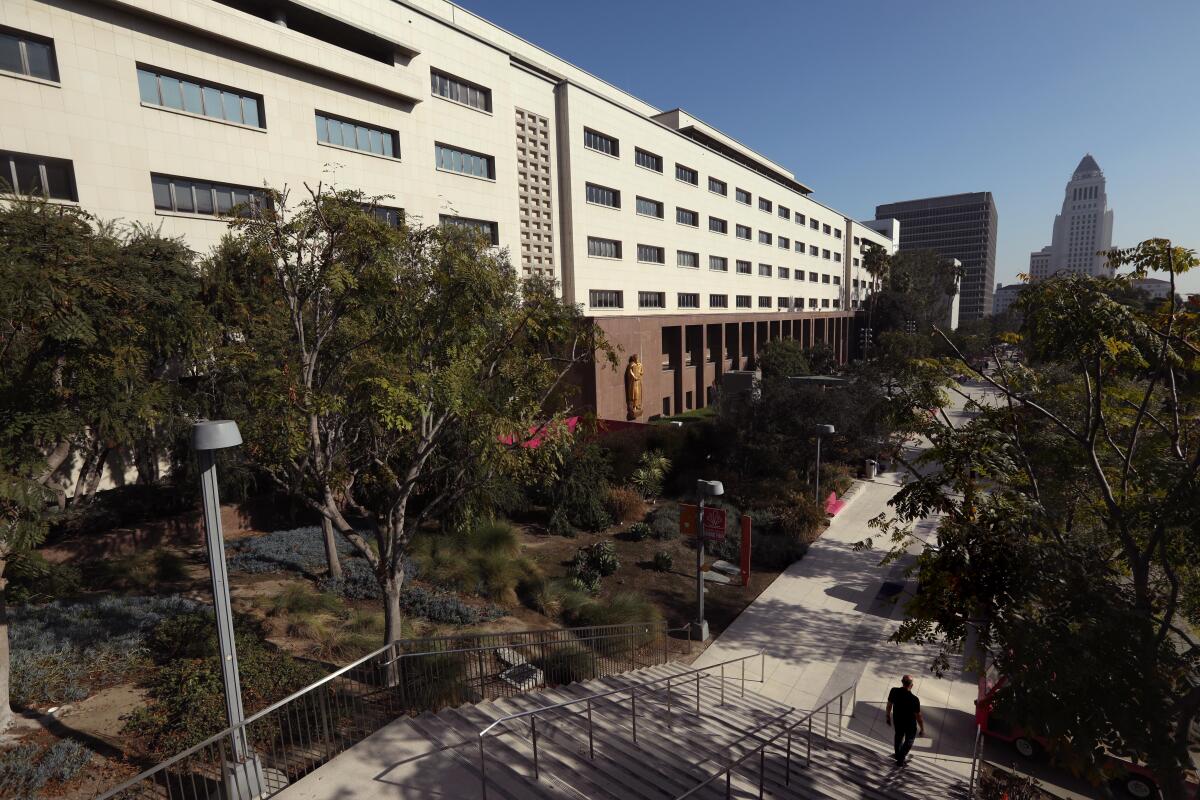Column: L.A. County’s Hall of Administration should stand, Janice Hahn says. And not because of her dad

- Share via
I drove around downtown Los Angeles on a recent Friday morning looking for one of the Civic Center’s ugly ducklings.
The Kenneth Hahn Hall of Administration … um, which building was it again?
It had been years since my only other visit, so unmemorable that I had forgotten how the ten-story structure looked. Google Maps gave me an address, but I was lost in a sea of architectural grandeur when I finally parked in a small lot near Temple and Grand. To my left was the majestic Cathedral of Our Lady of the Angels. Behind me were the Music Center’s elegant triplets of the arts: the Dorothy Chandler Pavilion, Mark Taper Forum and Ahmanson Theatre.
In front of me was a building with cream-colored tiles that connected to a taller building that looked the same, except with windows.
Oh, yeah. That’s the Hall of Administration.
Seat of the county of Los Angeles since it opened in 1960, it looks like a Lego block with slits. No wonder it’s never gotten as much love from Angelenos as its flashier neighbors, especially L.A. City Hall, which looms to the south like the haughty older civic cousin it is.
With the ink dry on the County of Los Angeles’ $200-million purchase of the Gas Co. Tower office building downtown, a fight is brewing over what to do with the 1960s-vintage headquarters it plans to leave behind.
That’s why there hasn’t been any uproar since the county Board of Supervisors voted in November to buy the 52-story Gas Co. Tower for $200 million — a bargain worthy of the late, great 99 Cents Only chain, since its appraised value is $632 million — with plans to relocate county workers there, from the Hall of Administration and elsewhere, as early as this summer.
Nearly a third of the purchase price came from funds originally set aside to seismically retrofit the Hall of Administration and update its electrical system, effectively sentencing the place to the literal and historical scrap heap. The county’s preliminary plan calls for razing it, except for the portion where the supervisors hold their public meetings.
The sole “no” vote came from Janice Hahn, daughter of the Hall of Administration’s legendary namesake, the longest-serving supervisor in L.A. County history. She was waiting for me in the parking lot to give me a tour of the unloved building and argue for its virtue — and survival.
“This is Nate’s Lot,” she told me, explaining that it was named after a parking attendant who told her father he didn’t like working in the Hall of Administration’s underground garage. So the supervisor created the lot just for him.
“There’s history like that all around in a building like this,” said Hahn, Starbucks chai latte in hand, as we walked through the doors. Three staffers accompanied us, including Mark Baucum, who is both her son and her chief of staff.
“It has a warm feel, not like …” Her face scrunched as if she had stepped on a snail, and she waited a beat before referencing the county’s recent purchase. “That soulless skyscraper.”

The halls gleamed with vintage charm. Marble walls and terrazzo floors. Frosted windows on doors with the old-school gold sans serif font long used by county departments. Phone booths that still work. Wood-paneled elevators that Janice and her brother, former L.A. mayor and current Superior Court Judge Jim Hahn, rode as kids like they were at an amusement park.
We walked through the spacious main lobby, where people waited in line to pay their property taxes, and out of the building toward Hill Street.
“That soulless skyscraper doesn’t have a lobby like this,” Hahn said. Across the street was the Hall of Records, built in 1962. To our left were the Stanley Mosk Courthouse, opened in 1959, and Gloria Molina Grand Park.
“They’re not on the chopping block,” she said, referring to the buildings. “People once thought City Hall was too expensive to retrofit. Were it not for civic-minded people, it would’ve been torn down. What a tragedy that would’ve been.”
As we rounded the Hall of Administration’s western side to look at large, gold-colored statues of Moses and Thomas Jefferson, the wear-and-tear of the 75-year-old building quickly became evident. Chunks missing from window ledges. Chipped granite base. Cracks on the walls here and there.
“Yes, it needs work,” Hahn acknowledged, as Baucum helped a woman who couldn’t tell the difference between the Hall of Administration and the Stanley Mosk Courthouse. “We had some of that money, but it was used to buy … that soulless skyscraper. And we have a budget of $50 billion. We can do this.”
Hahn estimated the cost to be $700 million. A spokesperson for L.A. County Chief Executive Officer Fesia Davenport said the seismic retrofit is expected to cost about $700 million, with renovations and other needed repairs bringing the estimated total to $1.8 billion.
The Los Angeles County Board of Supervisors on Wednesday approved the county’s purchase of the Gas Company Tower, one of downtown L.A.’
But should it be done? I wondered as we went back inside the Hall of Administration. What possible role could an empty building play, when the other four supervisors want to get the hell out of there, and all of the money set aside to take care of it has already been spent?
One person I figured might have some pity for the Hall of Administration was Supervisor Kathryn Barger. She’s worked there since 1989 — first as an aide, then as chief of staff to then-Supervisor Mike Antonovich, and for the last eight years in her current role.
“From an aesthetic point of view, not much there,” said Barger, who voted to buy the Gas Co. Tower, in a phone interview. “You go to City Hall, you’re like, ‘Wow.’”
She gets Hahn’s point that it’s a historic structure, but Barger is more focused on the price tag for renovation, which she put at $1.2 billion. “I cannot discount Janice, but we have to do right by the taxpayers,” she said.
Barger mentioned that the supervisors are going to need much more office space after voters in November approved an eventual expansion of the board from five members to nine. She also brought up the late Gloria Molina, who served alongside Kenneth Hahn and whom Barger got to know well while working for Antonovich.
“Her vision and dream was to create more open space, and it was always shot down,” Barger said. She suggested that the Board of Supervisors could knock down the Hall of Administration, which spans the length of two city blocks, and expand Gloria Molina Grand Park.
“This issue is emotional for [Hahn],” Barger said, “but you have to separate the emotional from the reality.”

Hahn brought up that charge herself, then disputed it.
“Every story written implies it’s because of my father,” Hahn told me as we stood in front of a plaque near the lobby praising Kenneth Hahn’s “unsurpassed legacy of good works” in 40 years as a county supervisor. He died in 1997.
“It’s not,” she continued. “People have said, ‘We’ll put his name on the skyscraper.’ Oh, hell no. He would’ve questioned the rationale of using certain budget stats to prove” the necessity of leaving the Hall of Administration, she said. “He would find holes in their argument and find $700 million to save this hall.”
The tour went on for about an hour, with Hahn greeting every single person she passed. We visited the Board of Supervisors’ meeting room, which will remain standing (“That’ll make a disjointed county government”), and finally went up to her office. A painting hangs near the entrance, depicting her on a couch with a portrait of her dad hovering above.
“This is my life,” Hahn cracked. “My dad always looking over my shoulder.”
We briefly sat down, then went outside to a terrace ringing the length of the Hall of Administration. The floor was peeling, but the view before us of the Civic Center and downtown was stunning.
Downtown real estate types say a purchase of the Gas Company Tower by L.A. County government could transform downtown — and Grand Park. Not every supe is on board.
I understood, and even appreciated, Hahn’s argument that moving the county offices from here, where other parts of L.A. government reside, would create “a gaping hole in the idea of civic togetherness,” as her son put it. But the fiscal reasoning against it was strong, I said, before asking if her crusade stood any chance of succeeding.
“I think so,” she said. “I think we’ll get the momentum. And Dad always loved a good fight.”
Her son pointed out a sliver of a skyscraper poking out behind another skyscraper. That was the Gas Co. Tower.
“Ugh,” the supervisor said, shaking her head. “Soulless.”
After we said our goodbyes, I walked the four blocks to Hahn’s Moby Dick, which was built in 1991. She wasn’t wrong. The exterior is a bunch of charmless windows going up and up. The lobby, with its collection of elevators, scowling security guards and small glass turnstiles, is cold and anodyne. No amount of bureaucratic lipstick can pretty up this political pig.
Maybe Hahn was right, I thought as I headed back to Nate’s Lot. Then I ran into Miguel Santana, president of the California Community Foundation and a longtime Molina confidante.
I know few people who care about L.A. history and responsible leadership as much as he does. What does he think about the county abandoning the Hall of Administration?
“Great!” he said, barely breaking his stride. “I’m all for it. Gloria always wanted to knock it down and turn it into more park.”
Good luck with your fight, Supervisor Hahn: You’re going to need it.
More to Read
Sign up for Essential California
The most important California stories and recommendations in your inbox every morning.
You may occasionally receive promotional content from the Los Angeles Times.














